They are both key channels for content marketers. They’re both inbound traffic sources. But social media and SEO are very different. In fact, they’re opposites.
Here’s the side-by-side breakdown of the differences (and similarities) between social media and SEO.

First, here’s the big picture:
- What is search engine optimization (SEO)?
SEO is about being discovered and getting traffic through search engine rankings. It fills the top of the funnel and creates awareness. - What is social media marketing?
Social media is about connecting, building relationships and getting traffic from social media networks. It strengthens the middle of the funnel and creates engagement.
Go one level deeper and you’ll find that the audiences, the actions and the outcomes are all very different.
Let’s take a close look at the opposite natures of social and search. This post will help you answer the search vs. social question for yourself, decide which content to promote in which channel, how to spend your time and where to set your expectations.
1. Audience psychology
Different context. Different mindset. Different intent.
The reasons people go to a search engine and open up a social media app are completely opposite. This is a useful way to think about it.
- Search users are busy
Users of search engines have specific needs and they know it. They type it into a search bar with the specific expectation of getting answers or help. - Social users are bored
Users of social media have time, but no specific goals. They’re tapping, not typing.
In other words, no one goes to Google to browse. And no one goes to social media with a plan. With this in mind content strategists need to find the fit between our topics and our promotion channels.
“But I heard that kids are using TikTok to search for stuff.” Probably, you’re referring to this quote from this article.
“In our studies, something like almost 40 percent of young people, when they’re looking for a place for lunch, they don’t go to Google Maps or Search. They go to TikTok or Instagram.”
Prabhakar Raghavan, Senior VP, Google
That quote is referring to a very narrow use case: lunch. TikTok (and social media more generally) is a terrible place to search for answers to questions. Try checking tomorrow’s weather on Instagram. Open TikTok and tell me Tom Hanks’ age. Try using Facebook to see how much Tylenol a 6 year-old can take.
First, the need or curiosity appears, then we select the place to satisfy that information need. In other words, we have channel preferences, but information needs.
Social pro, Adrienne Sheares, looked into this and summarized it nicely…
2. Topics
With the psychology of users in mind, we can quickly see why certain content, topics and headlines perform better in search. Other topics and headlines perform better in social media.
- Social media
Content that stirs an emotional response often does best, especially emotions such as anxiety, anger and awe. Trending topics often do well in social media. Strong opinion. - Search optimization
Research-based content often performs best, such as detailed, how-to instructional posts and articles that answer common questions. Evergreen topics that don’t quickly go out of style often are perfect for SEO.
Consider the following headlines. These are actual articles we’ve published and promoted, so we’re able to report on which channel worked well for each. It’s a social media vs. SEO showdown…
Example: 7 Habits of Highly Effective Content Marketers
This article/headline performed better in… social media

Why did it perform better in social media?
- This just isn’t a topic that people are looking for. What would the primary keyphrase be? “Content marketing habits?” Not something people are looking for.
- The headline piggybacks on a famous book title: “The 7 Habits of Highly Effective People”
Notice that I’m specifically talking about the performance of the headline. That’s because it’s really the headline that performs in social media. No one shares an entire article. We only share the headline.
Example: Web Design Standards: The 10 Best Practices from the Top 50 Websites
This article/headline performed better in… search!

Why did it perform better in search?
- It’s something that people look for. It answers a question: what features are standard on websites. It is aligned with a keyphrase.
- It’s not a very provocative topic. There’s nothing especially emotional or unexpected about the topic of web design standards. It’s kind of boring unless you’re already interested for some reason.
Example: 27 Picture of Desks – Top Marketers Share Tips for Cameras, Mics, Lights and Hamsters
Performed better in… social media!

Why did this perform in social media?
- It’s an unexpected headline. You probably haven’t seen this in your social stream before.
- It sounds both visual (pictures of desks) and scannable (list of 27) which means it’s not a big commitment. If you tap on this, you’ll get something easy to consume.
- It’s Behind-the-scenes (“BTS”) content, which feels exclusive. This gives it an element of social currency, which can increase sharing.
Example: How to Design a Better FAQ Page
Performed better in… search!

Why did this work so well in search?
- People need it when they need it. This kind of evergreen content is perfect for SEO because it’s on-demand.
- What are the odds that your average follower is designing an FAQ page today? Uh, pretty much zero, right? I’m amazed it got shared at all.
So we see that topics have channel-specific strengths and weaknesses, but what about formats?
3. Formats
Content marketing formats are the types of media in which the content is published. From the tiny tweet to the printed book, from the lean-back-and-watch video to the lean-in-and-read article, from the podcast in your ears to the live event in your town.
Here’s a quick list of popular formats. For a fun guide, check out the Periodic Table of Content.
- Text formats: blog articles, guides, ebooks
- Visual formats: videos, diagrams, memes
- Audio formats: podcasts
- Live formats: events, webinars
Some formats have natural advantages in some channels, search and social.
- Search engines: Long-form text
Detailed articles perform best in search, at least in the traditional organic rankings. The average high-ranking is 1000-1500 words long (source). Adding detail and indicating relevance is a key aspect of SEO. There’s a good reason Google loves Wikipedia. Those articles are very very detailed. - Social media: Video
Video captures the attention in fast moving social streams. No surprise that Instagram Stories are so popular and Facebook is focusing on Reels. And TikTok is still exploding. Short-form video is the fastest growing format on the web.
Of course, Google also knows how compelling visuals can be. Search results are getting more visual all the time. Beyond your traditional organic rankings, YouTube videos are appearing in search results everywhere.
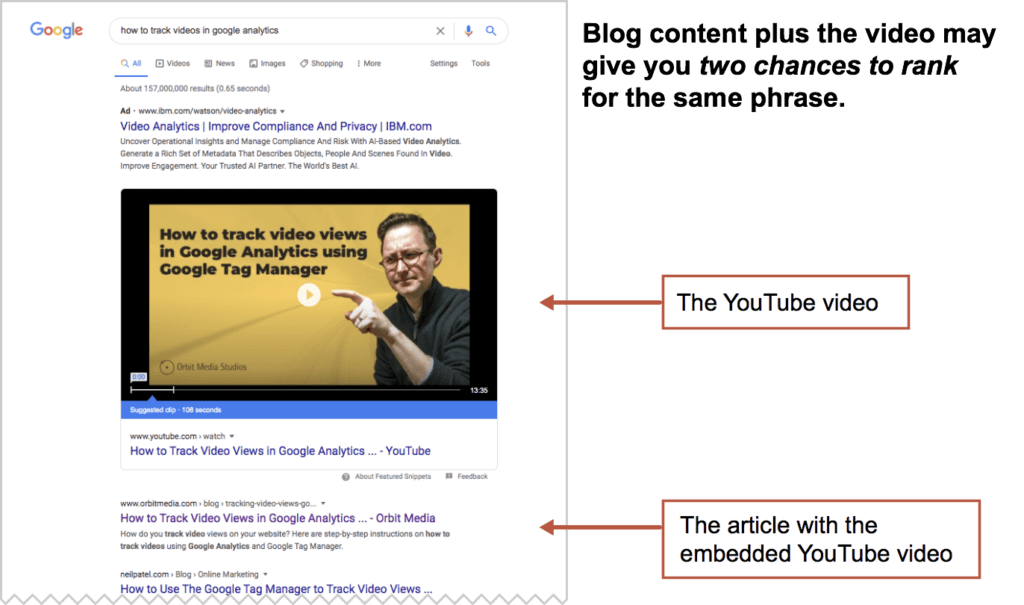
Source: Adding Video to Your Content Strategy
4. Paid targeting
We almost never mention paid marketing on this blog but it’s so interesting, let’s touch on it. And it perfectly highlights the social vs. search differences.
In social, you target the audience based on their demographics and behavior. In search, you target the audience based on what they typed.
- Paid search / PPC (pay per click)
You know everything about what they’re thinking, but you know nothing about who they are.
Good for: Pest exterminators. 🪳
If they need it, they search for it. They feel urgency. Bug problems are specific to a demographic. - Paid social
You know nothing about what they’re thinking but you know everything about who they are.
Good for: Cool sunglasses. 🕶️
They didn’t know they wanted them until they saw them. Now they have to have them.
Of course, paid social and paid search can work for all kinds of offers, topics and audiences. The examples above simply highlight the differences.
5. Influencers
Every piece of content is an opportunity to collaborate. Invite someone to cameo in your next video or contribute a quote for your next article. Better yet, use one of the intrinsically collaborative formats, such as roundups and interviews.
But different influencer collaborations have different advantages in different channels.
- Search engines: Subject matter experts
When the goal is to make the best page on the internet for an evergreen topic, you’re looking for quotes from subject matter experts that add insights and depth. It doesn’t really matter if they have a lot of Pinstagram followers. Examples: Research partners, journalists, authors - Social media: Social influencers
When the goal is to maximize reach and engagement, you’re looking to collaborate with people who have large and highly-engaged followings. It’s nice if they provide details and insights, but their ability to amplify is key. Examples: Strong/contrary perspectives, media personalities
Of course some potential collaborators are a mix of both, blending style with substance to create deep insights with wide social reach.
6. Upper limits
If everything goes well, what’s the upside? How much success is possible? Again, these two channels, social media and SEO, offer opposite opportunities.
- Search traffic: Topical maxima
There is a ceiling to the amount of traffic a page will get from a search engine. Traffic will never exceed the number of people who search for that topic each day. The total demand for the topic (the search volume) is the maximum amount of traffic the page will get from search engines. - Social media: Breathtaking virality
There is virtually no limit to the amount of traffic a page can get from social media. A huge number of people may share a piece of content. If you’ve ever seen the Analytics for content that has “gone viral,” you know just how far and how fast things can spread.
7. Speed and longevity
The efforts in search and social are totally different. And the longevity of the results is different. The element of time for both cost and benefit are complete opposites.
- Search engines: Slow, but durable
It takes time to build up the authority of a domain and the relevance of a page. Search optimized pages can take 10+ hours to write. If there’s not much competition for the phrase, it may appear high in results within days.
But when competition is fierce, it may take years of content updates and link building. But once a page is ranking, it may have durable visibility, creating an ongoing, passive source of visitors. Depending on the phrase and the page, high rankings may endure for weeks or months.
- Social media: Faster, but short lived
Although growing a following takes time, most social posts don’t take hours to create. They go live instantly. Visibility and engagement happen within minutes. But the post is quickly buried in fast moving social streams. Social pros know, this work requires a continuous, ongoing effort.
We can go back to our boat analogy from this post about website traffic sources. Every search optimized page can catch traffic, like a sail catches wind, creating an almost passive source of traffic over long periods of time. But social media is like oars on the boat. If you stop rowing, you stop getting results.
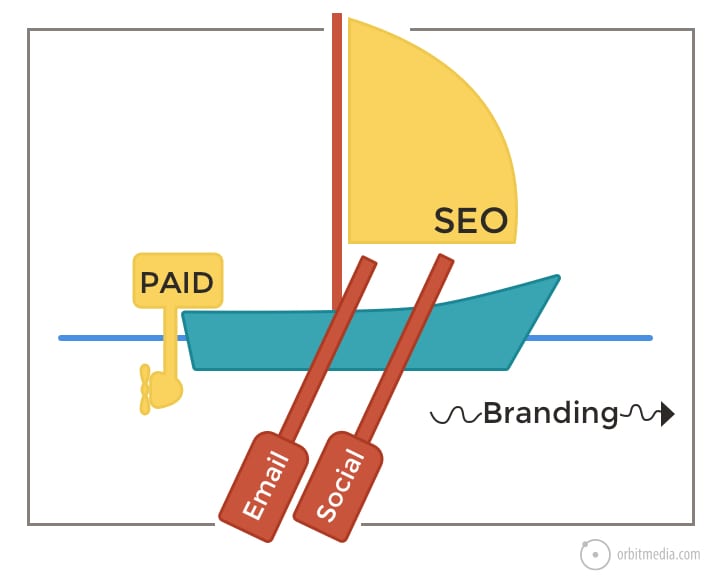
8. Conversions
When the intent is different, the conversion rates are different. Visitors who used a keyboard to get here are more likely to act than visitors who tapped on a piece of glass.
- Search engine conversion rates
They’re looking for something. They just searched for it. That’s why visitors from search are more likely to be ready to buy, but less likely to share and interact. These visitors enter with a specific purpose, need or question. They have strong intent. - Social Media conversion rates
They were really just browsing around when they found you. They really have no specific intent. But if you capture their attention, they may drop by for a visit. They may also share and spread awareness, influencing other potential buyers.
There are a lot of variables, of course, but check the data for yourself.
In GA4 check the Acquisition > Traffic acquisition report. Here I’ve moved the Conversion column over to the left. And because “conversion rates” aren’t yet part of GA4, you need to do the math yourself. Divide conversions by users (or sessions, really) and you’ll have your conversion rate.
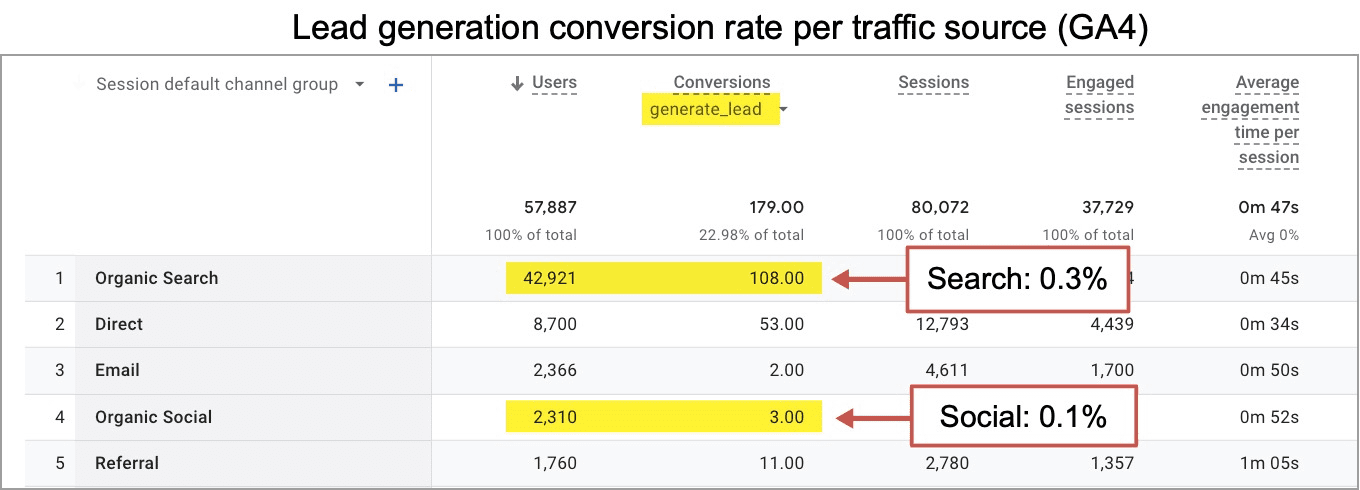
If those numbers look abysmally low, keep in mind that there are a lot of high-traffic articles in this account. That traffic pushes down conversion rates, especially for the lead generation goal.
9. Measurement
Beyond conversion rates, we use two sets of metrics for our two channels. Search metrics are more accurate because search traffic comes mostly from one website. Social media traffic is harder to measure because social traffic comes to us from a wide range of websites and apps.
- SEO metrics
Google Search Console shows pages and queries, but it doesn’t track specific rankings for specific pages. The closest it comes is “Average Position” which you can find using these steps. You’ll need a paid tool to track rankings for specific phrases.
But you can use Analytics to track the changes in search traffic to your pages over time. Use the Engagement > Pages and screens report. Here’s what it will look like, with all of the little configurations highlighted.
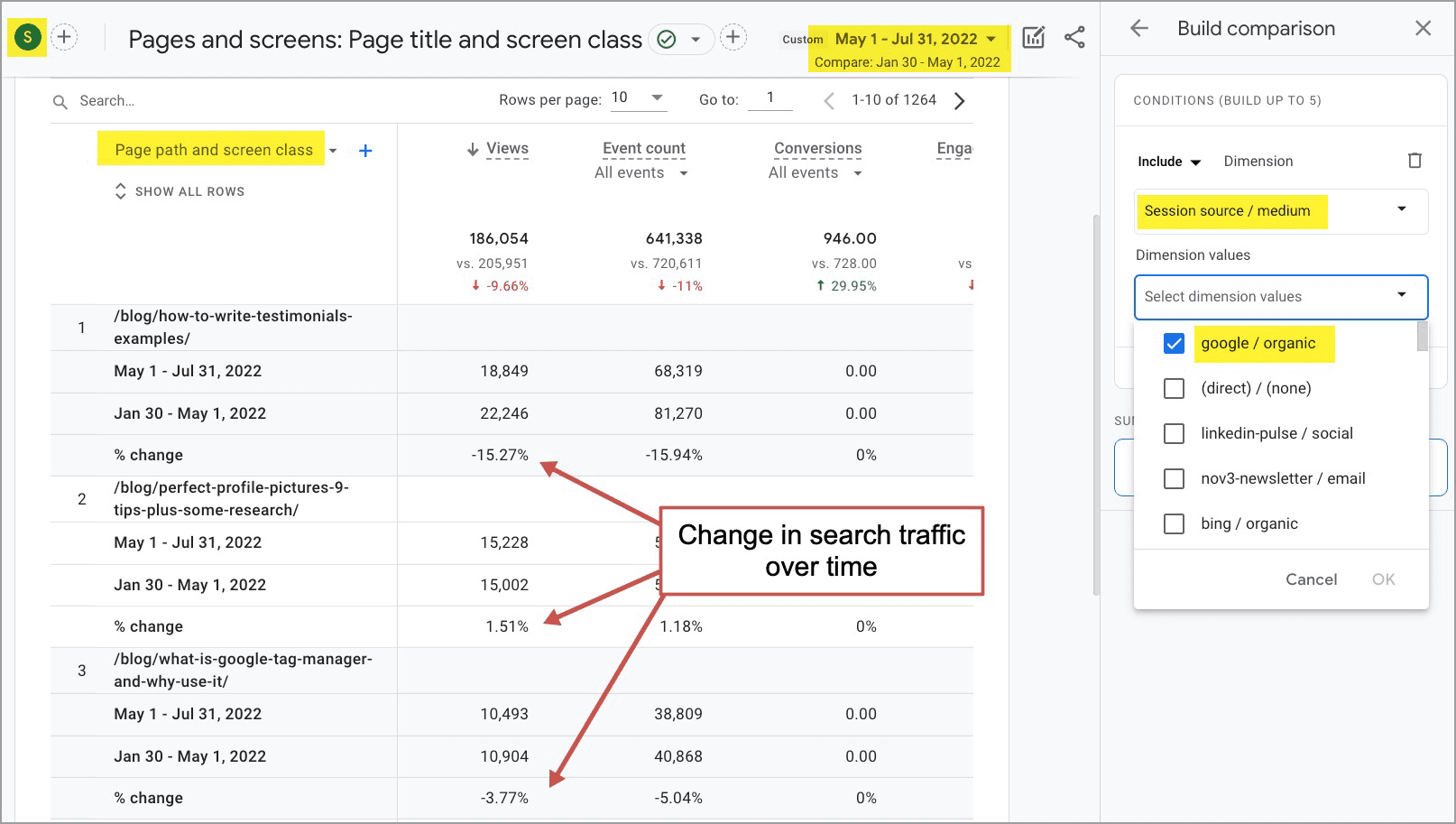
- Social media
Shares, likes and comments are all highly visible. But to accurately track social media traffic on your website, you need to use a URL builder to add campaign tracking codes. Once the campaign tracking codes are in place, you can track website engagement.
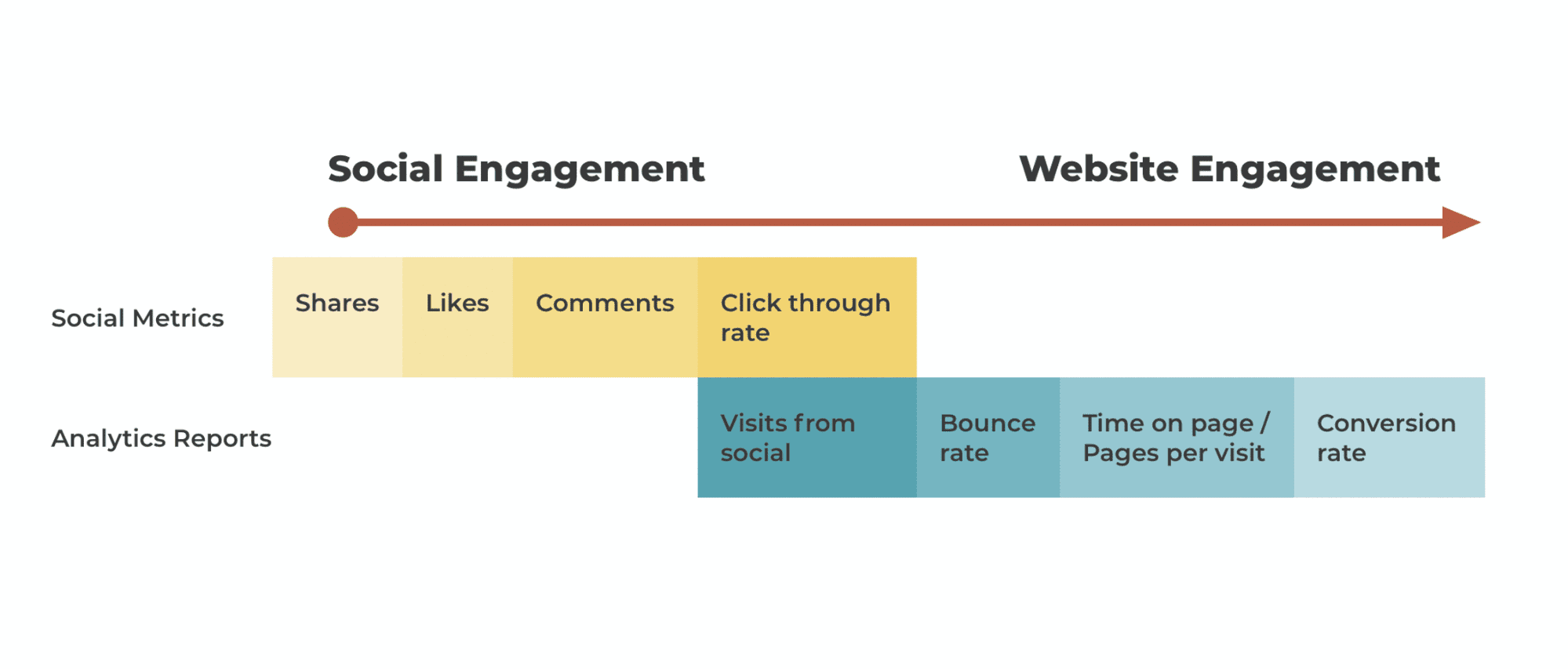
This is one of several ways to track social media traffic. This video gives you a more complete rundown.
Here’s how they help each other
“You can’t do SEO without using social media.”
“You need to use search to do social media right.”
These might be overstatements, but they’re common. If you watch a social media pro at work, they’re doing research in Google. The reverse is also true. SEOs dig through social media while researching topics and collaborators.
So the final two bullets in our social media vs. SEO comparison show how the two channels work together.
- How social media helps SEO
Social profiles often rank in search. And search visibility of content often drives follows and shares. - How SEO helps social media
Relationships formed in social media often lead to the collaborations and links that drive rankings. Research and networking




